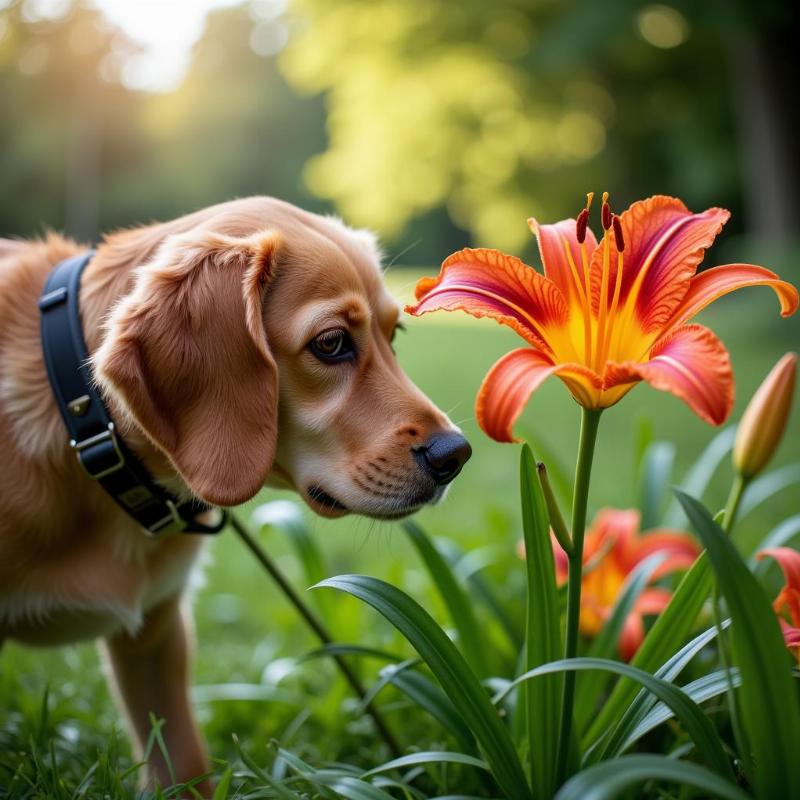Keeping your furry friend safe and healthy is a top priority for every dog owner in the US. One often overlooked danger lurking in our homes and gardens are toxic plants. Knowing which plants dogs don’t like, or more importantly, which ones pose a threat, is crucial for responsible pet ownership. This guide provides valuable information on common plants toxic to dogs, helping you create a safe environment for your beloved canine companion.
Identifying Common Toxic Plants
Many seemingly harmless plants can cause mild to severe reactions in dogs, ranging from digestive upset to organ failure. Some common culprits include sago palms, tulips, azaleas, oleander, and castor beans. Even seemingly innocuous plants like lilies can be extremely dangerous, especially to cats, and should be avoided entirely. Recognizing these plants is the first step towards protecting your dog.
 Dogs and Lily Flowers
Dogs and Lily Flowers
Did you know that even some common houseplants can be harmful to dogs? For example, the peace lily, while beautiful, can cause irritation and digestive issues if ingested. It’s important to research any plant you bring into your home to ensure it’s safe for your furry family member. You can refer to the ASPCA’s comprehensive list of toxic and non-toxic plants for pets as a reliable resource.
Signs of Plant Poisoning in Dogs
If your dog ingests a toxic plant, they may exhibit a variety of symptoms. These can include vomiting, diarrhea, lethargy, loss of appetite, drooling, tremors, and difficulty breathing. If you suspect your dog has eaten a poisonous plant, seek immediate veterinary attention. Time is of the essence in these situations.
Creating a Dog-Friendly Garden
Protecting your dog from toxic plants doesn’t mean you have to sacrifice having a beautiful garden. Many dog-friendly alternatives exist, such as sunflowers, zinnias, and snapdragons. Creating a designated dog-friendly area within your garden, fenced off from potentially harmful plants, is a practical solution.
Tips for Keeping Dogs Away from Plants
- Training: Train your dog to avoid certain areas of your garden using positive reinforcement methods.
- Physical barriers: Use fencing or raised garden beds to create a barrier between your dog and toxic plants.
- Distraction: Provide plenty of dog-friendly toys and activities to keep your dog entertained and away from plants.
- Supervision: Always supervise your dog when they are in the garden.
“Prevention is always the best medicine,” says Dr. Emily Carter, a veterinarian specializing in toxicology at the Animal Medical Center of New York. “By educating yourself about toxic plants and taking proactive steps to create a safe environment, you can significantly reduce the risk of plant poisoning in your dog.”
Conclusion
Understanding which plants dogs don’t like and pose a danger to them is essential for responsible dog ownership. By being aware of the potential hazards in your home and garden, and taking appropriate preventative measures, you can ensure your canine companion enjoys a long, healthy, and happy life. Remember to always consult with your veterinarian if you have any concerns about your dog’s health.
FAQ
- What should I do if my dog eats a poisonous plant? Immediately contact your veterinarian or the ASPCA Animal Poison Control Center.
- Are all lilies toxic to dogs? While all lilies are considered toxic, certain varieties pose a more significant threat than others. It’s best to err on the side of caution and avoid all lilies.
- Can I use commercial plant repellents to keep my dog away from plants? Some commercial repellents may be safe for dogs, but always check the label and consult with your veterinarian before using them.
- How can I make my garden more appealing to my dog? Incorporate dog-friendly plants, create designated digging areas, and provide plenty of shade and water.
- Where can I find a comprehensive list of plants toxic to dogs? The ASPCA website offers a searchable database of toxic and non-toxic plants.
- What are some common signs of plant poisoning in dogs? Vomiting, diarrhea, lethargy, loss of appetite, drooling, tremors, and difficulty breathing.
- Are there any indoor plants that are safe for dogs? Yes, there are several safe options, including spider plants, Boston ferns, and prayer plants. However, always research a plant thoroughly before bringing it into your home.
Beautdogs.us is your premier resource for all things dog-related in the US. We offer expert advice on dog breeds, care, and products, catering to both new and experienced dog owners. Our mission is to empower you with the knowledge and resources you need to provide the best possible care for your furry friend. Contact us today for more information at [email protected] or +1 501-555-7529. Visit Beautdogs.us for more expert advice and discover a world of valuable resources dedicated to your canine companion.